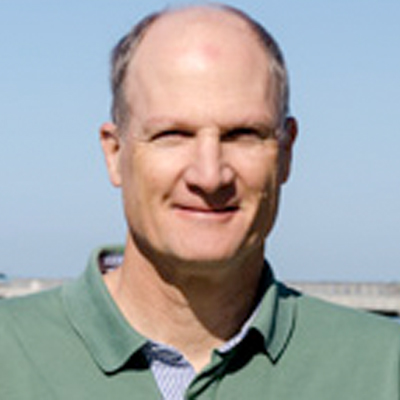Combining oceanographic models with data for more accurate predictions
Within the scientific community, there is a great deal of modelling occurring around the world, from climate and weather models to oceanographic models, all of which are designed to make useful predictions of future events. Both meteorology and oceanography are transitioning from an “art,” where experienced scientists can predict what will happen better than computers, to a science, where the equations that determine the behavior can be solved on a computer for better understanding and testing. These models have become much better over the past 20 years and are increasing in accuracy, but the possibility of useful atmospheric forecasts beyond a week or two is still under study. Dr. Bruce Cornuelle is dissecting and analyzing oceanographic models to identify their flaws and improve them so that they may be used to make accurate predictions at ranges longer than a few weeks. Whereas the atmosphere has a “short-term memory” because minor disturbances can have great effects down the road (Butterfly effect), the ocean moves much more slowly and has a longer memory. The oceans store most of the heat that the earth receives from the sun, and can move that heat around the world, possibly exerting tremendous influence over global climate and weather. The ability to predict events quantitatively on a longer time scale would be extremely valuable, with applications in a number of fields and disciplines. Suppose, for example, that we could inform farmers in the midwest that they can expect a drought in the upcoming months, or, conversely, excess rain. This information could let them plant crops consistent with the expected rainfall, and could enable reservoir management to save water for droughts or release it to eliminate flooding. Dr. Cornuelle’s work as part of the conversion of weather and oceanography from an art to a quantitative science is hoped to eventually lead to more accurate predictions of climate and weather for farmers, fishers, oil rig operators, and other stakeholders invested in the state of the oceans.
As a data analyst, Dr. Bruce Cornuelle, a research oceanographer at the Scripps Institution of Oceanography at the University of California, San Diego, uses ocean observations to quantify and improve the accuracy of mathematical ocean models. After identifying ways of improving a model and its ocean state, they make useful predictions which also serve to further test the model. A model is a physical system - simplified, a model of a ball rolling down a hill can predict the speed and trajectory of the ball given its initial conditions, i.e., what direction it was pushed, what force was initially applied to the ball, etc. If the prediction given by the model does not match the trajectory that the ball actually rolled, then something is wrong. If the initial conditions were uncertain, then we can go back, readjust the initial controls, and run the simulation again for a more accurate prediction. The same is true with oceanographic models. Output data from these models is tested against ocean observations collected both internationally and by SIO. If the model and data do not match, such as, for example, incorrect temperature or salinity, that is an indication that the model may not be entirely accurate. He is working with community oceanographic models, including the MIT General Circulation Model, the Regional Ocean Modeling System, and others, and intends to extend the same quantitative testing principles to atmospheric and coupled ocean-atmospheric models. A byproduct of the understanding of the model and related observations is predictions of the ocean that can be useful for people with interests in these regions, such as the tropical Pacific (ENSO), the California Current, and the Kuroshio region.
Dr. Cornuelle’s current research works with the analysis of various oceanographic models:
- California Current System: Off the west coast of the United States there is a network of currents and oceanographic systems that extend halfway to Hawaii which houses an important ecosystem, including fisheries and ocean recreation (e.g. surfing, swimming, diving) areas in this region. The coastal climate is strongly affected by the ocean, and it is responsible for much of the moderation in temperature near the coast. There is great interest in predicting what will happen in time, and in understanding how things in the ecosystem and physical climate will change in response to physical changes, such as the warming of the ocean or a change in pH. Current models of the California current are being analyzed for their accuracy and potential use as an analysis tool. This could be used to answer questions like, “Why was the water unusually warmer this year?”
- Gulf of Mexico Loop Current: Before it reaches the coast of Florida, the Gulf Stream begins as a strong current that comes in from the southwest Caribbean Sea. It enters the Gulf of Mexico between Mexico and Cuba heading north, loops, turns south, and then exits to the east off the coast of Florida and into the Atlantic. This is an interesting phenomenon because the loop can grow larger or smaller, and by bringing warmer water in from the Caribbean it can affect weather patterns and strengthen storms. This is what is believed to have made Hurricane Katrina particularly devastating when it hit New Orleans; it is believed the Loop Current was laden with warm water, strengthening the hurricane. These currents are very strong, and can affect oil operations, and the fate of oil particles in the event of a spill, such as the 2010 BP oil spill. Understanding the currents and the models based on that understanding can lead to predictions that would be useful for oil companies and others with interest in the Gulf.
- Atmospheric Modeling: Dr. Cornuelle is hoping to translate his expertise with oceanographic model analysis to atmospheric models in a project in collaboration with atmospheric scientists. Using the same tools he uses for the analysis of oceanographic models, Dr. Cornuelle will analyze atmospheric models to make better predictions of atmospheric rivers, relatively narrow regions in the atmosphere that are responsible for most of the transport of water vapor outside of the tropics, which hit the west coast of the U.S. and have the potential to bring flood or famine. Atmospheric rivers are responsible for bringing a large fraction of the rain seen along the west coast, but their detailed predictability has not been quantified. This understanding is critical for improving the management of water control systems; it could be the difference between filling a reservoir and allowing a flood. Winter generally brings storms, and in expectation of a large storm, reservoir controllers will let go of precious fresh water so that the reservoirs do not overflow. If these actions are taken and it doesn't rain though, that is a large waste of perhaps the most valuable resource in Southern California. Dr. Cornuelle’s analysis of atmospheric models should allow for a better understanding of atmospheric rivers and better predictions of storms for reservoir and freshwater management.
Bio
Dr. Cornuelle lived near the ocean during much of his childhood, and enjoyed spending time swimming and playing in it, and simply being near it. Growing up, he was also interested in how things worked, the physics of: rockets, cars, televisions, radios. This provided a natural segue into studying physics at Pomona College. A lucky break found Dr. Cornuelle attending a summer program at Woods Hole Oceanographic Institution in Woods Hole, MA, where he was able to snorkel as part of his research curriculum. This experience not only reminded Dr. Cornuelle of his long-standing love for the ocean, but also opened his eyes to the world of research. As an undergraduate student at a small liberal arts college, there was not much scientific research occurring, and so before the program, collegiate research was an alien world. The summer program at Woods Hole showed Dr. Cornuelle another side of academics; he found it interesting and enticing and so after graduating with his bachelor’s applied for graduate school in oceanography.
During his graduate studies, Dr. Cornuelle worked with an outstanding advisor who introduced him to modern methods for data analysis using models, ultimately directing Dr. Cornuelle’s future career. With respect to his current work, Dr. Cornuelle enjoys the idea of potential practical benefits that stem from his research. He is motivated by the long-term possibility of predicting weather, especially precipitation, far enough in advance for people to be able to truly utilize those predictions. He enjoys the practical aspects of science.
Fitting for an oceanographer, Dr. Cornuelle is a enthusiast of the environment. He loves the outdoors and the natural landscapes of the Earth, and spends much time outside, hiking, camping, swimming, surfing, snorkeling, and diving. He coordinates his outdoor activities with the raising of his 6-year-old daughter, to whom he is hoping to communicate his same appreciation of the environment.


